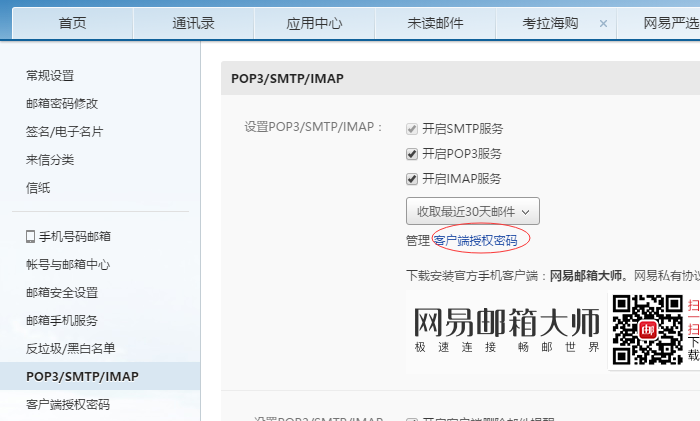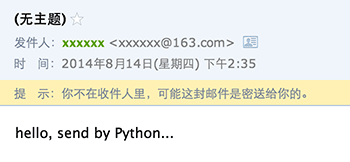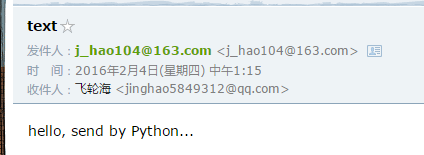 Backend Development
Backend Development
 Python Tutorial
Python Tutorial
 Detailed explanation of the process of sending emails using Python's smtplib module
Detailed explanation of the process of sending emails using Python's smtplib module
Detailed explanation of the process of sending emails using Python's smtplib module
1. Log in to the SMTP server
First use the online method (use 163 email here, smtp.163.com is the smtp server address, 25 is the port number):
import smtplib
server = smtplib.SMTP('smtp.163.com', 25)
server.login('j_hao104@163.com', 'password')
Traceback (most recent call last):
File "C:/python/t.py", line 192, in <module>
server.login('j_hao104@163.com', 'password')
File "C:\Python27\lib\smtplib.py", line 622, in login
raise SMTPAuthenticationError(code, resp)
smtplib.SMTPAuthenticationError: (535, 'Error: authentication failed')
Found return:
smtplib.SMTPAuthenticationError: (535, 'Error: authentication failed')
, prompting verification failure.
Some people say that python does not support the SMTP service, or the service is not turned on. But I remembered that the last time I used foxmail to log in to my 163 mailbox, I entered the correct password and it still prompted me that the password was wrong. The final solution is: QQ and 163 mailboxes now have client passwords, use a third-party When logging in, you need to use the client password to log in, and the same is true for Python, so set the client password and then log in with the client password.

import smtplib
server = smtplib.SMTP('smtp.163.com', 25)
server.login('j_hao104@163.com', 'clientPassword')
At this point, the login success prompt will be returned:
(235, 'Authentication successful')
2. Send email
First use the code given online:
import smtplib
from email.mime.text import MIMEText
server = smtplib.SMTP('smtp.163.com', 25)
server.login('j_hao104@163.com', 'clientPassword')
msg = MIMEText('hello, send by Python...', 'plain', 'utf-8')
server.sendmail('j_hao104@163.com', ['946150454@qq.com'], msg.as_string())
When constructing a MIMEText object, the first parameter is the email body, the second parameter is the MIME subtype, and the last parameter is the encoding method.
Sendmail is a method for sending emails. The first parameter is the sending email address, and the second parameter is the recipient email address. It is a list, which means it can be sent to multiple people at the same time. as_string turns the MIMEText object into str.
But the execution result cannot get the result mentioned online:

Instead:
Traceback (most recent call last):
File "C:/python/t.py", line 195, in <module>
server.sendmail('j_hao104@163.com', ['946150454@qq.com'], msg.as_string())
File "C:\Python27\lib\smtplib.py", line 746, in sendmail
raise SMTPDataError(code, resp)
smtplib.SMTPDataError: (554, 'DT:SPM 163 smtp11,D8CowEDpDkE427JW_wQIAA--.4996S2 1454562105,please see http://mail.163.com/help/help_spam_16.htm?ip=171.221.144.51&hostid=smtp11&time=1454562105')
After searching online, I found out: smtplib.SMTPDataError: (554, 'DT:SPM 163 smtp11... The error is because the envelope sender and letterhead sender do not match. It can be seen that there is no sending in the picture People and topics, so the code needs to be modified as follows:
import smtplib
from email.header import Header
from email.mime.text import MIMEText
server = smtplib.SMTP('smtp.163.com', 25)
server.login('j_hao104@163.com', 'clientPassword')
msg = MIMEText('hello, send by Python...', 'plain', 'utf-8')
msg['From'] = 'j_hao104@163.com <j_hao104@163.com>'
msg['Subject'] = Header(u'text', 'utf8').encode()
msg['To'] = u'飞轮海 <jinghao5849312@qq.com>'
server.sendmail('j_hao104@163.com', ['946150454@qq.com'], msg.as_string())
This way you can successfully send the email
The specific information in msg can be tested by sending an email using the normal email method

3. Reference example
import smtplib
from email.mime.text import MIMEText
to_list = ['123@123.com', '456@456.com']
server_host = 'smtp.163.com'
username = '你的邮箱账号'
password = '你的邮箱密码'
def send(to_list, sub, content):
'''
:param to_list: 收件人邮箱
:param sub: 邮件标题
:param content: 内容
'''
me = "manager" + "<" + username + ">"
# _subtype 可以设为html,默认是plain
msg = MIMEText(content, _subtype='html')
msg['Subject'] = sub
msg['From'] = me
msg['To'] = ';'.join(to_list)
try:
server = smtplib.SMTP()
server.connect(server_host)
server.login(username, password)
server.sendmail(me, to_list, msg.as_string())
server.close()
except Exception as e:
print str(e)
if __name__ == '__main__':
send(to_list, "这个是一个邮件", "<h1>Hello, It's test email.</h1>")

Hot AI Tools

Undresser.AI Undress
AI-powered app for creating realistic nude photos

AI Clothes Remover
Online AI tool for removing clothes from photos.

Undress AI Tool
Undress images for free

Clothoff.io
AI clothes remover

Video Face Swap
Swap faces in any video effortlessly with our completely free AI face swap tool!

Hot Article

Hot Tools

Notepad++7.3.1
Easy-to-use and free code editor

SublimeText3 Chinese version
Chinese version, very easy to use

Zend Studio 13.0.1
Powerful PHP integrated development environment

Dreamweaver CS6
Visual web development tools

SublimeText3 Mac version
God-level code editing software (SublimeText3)

Hot Topics
 PHP and Python: Different Paradigms Explained
Apr 18, 2025 am 12:26 AM
PHP and Python: Different Paradigms Explained
Apr 18, 2025 am 12:26 AM
PHP is mainly procedural programming, but also supports object-oriented programming (OOP); Python supports a variety of paradigms, including OOP, functional and procedural programming. PHP is suitable for web development, and Python is suitable for a variety of applications such as data analysis and machine learning.
 Choosing Between PHP and Python: A Guide
Apr 18, 2025 am 12:24 AM
Choosing Between PHP and Python: A Guide
Apr 18, 2025 am 12:24 AM
PHP is suitable for web development and rapid prototyping, and Python is suitable for data science and machine learning. 1.PHP is used for dynamic web development, with simple syntax and suitable for rapid development. 2. Python has concise syntax, is suitable for multiple fields, and has a strong library ecosystem.
 PHP and Python: A Deep Dive into Their History
Apr 18, 2025 am 12:25 AM
PHP and Python: A Deep Dive into Their History
Apr 18, 2025 am 12:25 AM
PHP originated in 1994 and was developed by RasmusLerdorf. It was originally used to track website visitors and gradually evolved into a server-side scripting language and was widely used in web development. Python was developed by Guidovan Rossum in the late 1980s and was first released in 1991. It emphasizes code readability and simplicity, and is suitable for scientific computing, data analysis and other fields.
 Python vs. JavaScript: The Learning Curve and Ease of Use
Apr 16, 2025 am 12:12 AM
Python vs. JavaScript: The Learning Curve and Ease of Use
Apr 16, 2025 am 12:12 AM
Python is more suitable for beginners, with a smooth learning curve and concise syntax; JavaScript is suitable for front-end development, with a steep learning curve and flexible syntax. 1. Python syntax is intuitive and suitable for data science and back-end development. 2. JavaScript is flexible and widely used in front-end and server-side programming.
 Can vs code run in Windows 8
Apr 15, 2025 pm 07:24 PM
Can vs code run in Windows 8
Apr 15, 2025 pm 07:24 PM
VS Code can run on Windows 8, but the experience may not be great. First make sure the system has been updated to the latest patch, then download the VS Code installation package that matches the system architecture and install it as prompted. After installation, be aware that some extensions may be incompatible with Windows 8 and need to look for alternative extensions or use newer Windows systems in a virtual machine. Install the necessary extensions to check whether they work properly. Although VS Code is feasible on Windows 8, it is recommended to upgrade to a newer Windows system for a better development experience and security.
 How to run sublime code python
Apr 16, 2025 am 08:48 AM
How to run sublime code python
Apr 16, 2025 am 08:48 AM
To run Python code in Sublime Text, you need to install the Python plug-in first, then create a .py file and write the code, and finally press Ctrl B to run the code, and the output will be displayed in the console.
 Can visual studio code be used in python
Apr 15, 2025 pm 08:18 PM
Can visual studio code be used in python
Apr 15, 2025 pm 08:18 PM
VS Code can be used to write Python and provides many features that make it an ideal tool for developing Python applications. It allows users to: install Python extensions to get functions such as code completion, syntax highlighting, and debugging. Use the debugger to track code step by step, find and fix errors. Integrate Git for version control. Use code formatting tools to maintain code consistency. Use the Linting tool to spot potential problems ahead of time.
 How to run python with notepad
Apr 16, 2025 pm 07:33 PM
How to run python with notepad
Apr 16, 2025 pm 07:33 PM
Running Python code in Notepad requires the Python executable and NppExec plug-in to be installed. After installing Python and adding PATH to it, configure the command "python" and the parameter "{CURRENT_DIRECTORY}{FILE_NAME}" in the NppExec plug-in to run Python code in Notepad through the shortcut key "F6".





